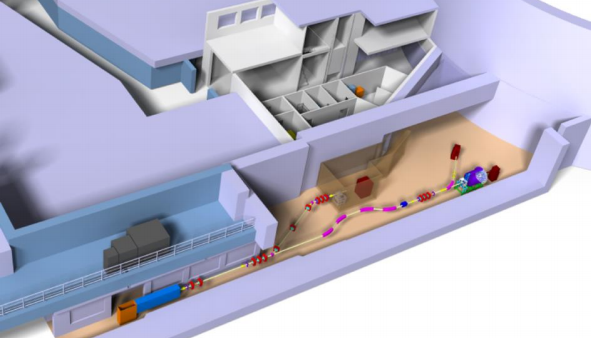PRAE
THE PROJECT:
The PRAE facility, currently under construction on the Orsay campus, is a multidisciplinary platform based on a new generation high-performance linear accelerator delivering a pulsed electron beam in the 30-70 MeV energy range, scalable up to 140 MeV. This project is the result of the complementary expertise of several local scientific research communities involved in radiobiology, subatomic physics, instrumentation and particle accelerator technologies. The electron energy range from 50 MeV to 140 MeV is used to study the feasibility and radiobiology of less destructive radiotherapy treatments based on innovative techniques.
In the field of subatomic physics, the ProRad experiment studies electron-proton elastic scattering to accurately measure the electrical form factor of the proton in an unexplored range of four ultra-low square moments. In addition, a fully equipped instrumentation platform provides the tools for the development of a new generation of detectors used in many research fields (medical imaging, subatomic and particle physics, space technology and astrophysics). With a first beam scheduled for 2021, the PRAE facility will represent a unique platform available to the academic and non-academic communities and for the development of outreach programmes for students.
ACCELERATOR TECHNOLOGY:
The PRAE accelerator is a high-performance electron accelerator consisting of a photoinjector, an accelerating section followed by a 3.5 m drift, which will accommodate a second accelerating structure in a second phase. The main beamline then splits into a direct and a deflected line. The direct line comprises an energy compression system coupled to a tearing structure to reduce the beam energy dispersion to the few 10-4s required for ProRad operation. The deflected line includes several magnetic elements to cope with different beam scenarios: electron focusing, mini-beam grid.

RADIOBIOLOGY:
Radiotherapy (RT) is one of the main cancer treatment techniques aimed at delivering a sufficiently high dose of radiation to the tumour to control the progression of the cancer, without causing serious complications to the surrounding healthy organs. However, despite the enormous progress made, some radioresistant cancers cannot be cured, mainly because of the limited dose that can be tolerated by normal tissues. Light ion beam therapy has been a major advance in recent decades in improving treatment efficacy, but its high cost and size limit the number of patients who can benefit. Another approach to widening the therapeutic window for cancer treatment is to protect normal tissue using the concept of spatially fractionated radiotherapy (SFR). This method has proven to be safe and effective in delivering large cumulative doses without causing severe damage to healthy tissue, especially with the GRID (centimetre-sized collimated beams) irradiation technique.
The combination of VHEE (very high energy electrons) with the advantages of GRID therapy has recently been proposed. By varying physical parameters such as beam energy, grid size and spacing, it is possible to enhance tumour exposure by delivering a quasi-homogenous dose to the tumour, or to improve tolerance of normal tissue by expanding the fractionated dose area. The first objective of the PRAE radiobiology project is to implement this totally innovative approach on the deflected beam line in order to evaluate its therapeutic benefit. High beam performance is a key point for the success of this investigation which requires sub-millimetre beam sizes, low beam divergence, high energies, high stability and reproducibility.

THE PRORAD EXPERIMENT:
The ProRad (Proton Radius) experiment is designed to provide accurate measurements of the ratio of effective cross sections between elastic and Møller electron scatterings. The facility follows simple and robust considerations for the identification, position and energy measurements of particles in a non-magnetic environment at energies well below the pion production threshold. The reaction chamber houses a target consisting of a 15 m diameter solid hydrogen jet, a 2 m long vacuum chamber is closed by a plug which supports the detector elements. They consist of 28 elementary cells symmetrically arranged around the beam and located at different scattering angles. The elementary cell consists of two layers of thin scintillator strips followed by a cylindrical BGO crystal. The scintillator hodoscope acts as a neutral particle discriminator, a charged particle marker and a position detector that defines the scattering angle of the electrons. Overall, ProRad represents an experimental challenge at the frontier of precision.
VALORISATION:
Unfortunately, the PRAE project stopped before it could achieve these objectives.
